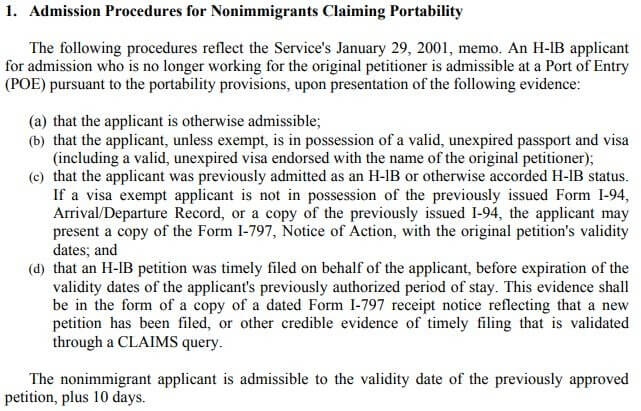- Introduction
- Policy Background
- When a Petitioner is Required to File a New or Amended H1B Petition Based on Simeio
- Related Scenarios When Petitioner is Not Required to File New or Amended H1B Petition
- Complying with Simeio
- Additional Notes on Amended Petitions
- Conclusion
Introduction
On July 21, 2015, the United States Citizenship and Immigration Services (USCIS) published Policy Memorandum (PM)-602-0120, titled “USCIS Final Guidance on When to File an Amended or New H-1B Petition After Matter of Simeio Solutions, LLC” (“the Memo”) [PDF version]. The Memo provides guidance to all USCIS employees about the implementation of the Administrative Appeals Office (AAO) immigration precedent decision in Matter of Simeio Solutions, LLC, 26 I&N Dec. 542 (AAO 2015) [PDF version]. In Matter of Simeio Solutions, the AAO held that an H1B employer must file either a new or an amended H1B petition if it moves an H1B employee to a location where a new Labor Condition Application (LCA) is required.
In this article, we will review the USCIS’s policy guidance for implementing Matter of Simeio Solutions, LLC. Please see our companion article for a full discussion of the underlying AAO decision [see article]. Please also see our article on the U.S. Department of State’s (DOS’s) guidance for consular officers regarding the Matter of Simeio Solutions, LLC precedent [see article]. We have collected our Matter of Simeio Solutions, LLC articles into an article index [see index].
Policy Background
Because the Memo was written to provide guidance on the implementation of Matter of Simeio Solutions, LLC, it first addressed the AAO’s holding. The Memo related the two key points of the decision (quoted):
1. A change in the place of employment of a beneficiary to a geographical area requiring a corresponding LCA to be certified to the Department of Homeland Security (DHS) with respect to that beneficiary may affect eligibility for H-1B status; it is therefore a material change for purposes of 8 C.F.R. 214.2(h)(2)(i)(E) and 11(i)(A) (2014).
2. When there is a material change in the terms and conditions of employment, the petitioner must file an amended or new H-1B petition with the corresponding LCA.
Before continuing, it is important to note that point 1’s reference to the DHS encompasses the USCIS. This is because the USCIS is the immigration component of the DHS that adjudicates H1B petitions.
The Memo summarized the AAO holding: “This precedent decision represents the USCIS position that H-1B petitioners are required to file an amended or new petition before placing an H-1B employee at a new place of employment not covered by an existing, approved H-1B petition.”
In short, the AAO decision takes the position that when an H1B employer moves an H1B employee to a new worksite that is not covered by the LCA associated with the approved H1B petition, a “material change” in the employment of the H1B employee has occurred. Under the cited to regulations, an H1B employer must file a new or amended H1B petition in the event of a change in the conditions of H1B employment that materially affect the beneficiary’s continuing eligibility for H1B classification. Therefore, in cases where the H1B petitioner moves the H1B beneficiary to a worksite not covered by the LCA associated with the approved H1B petition, the petitioner must file a new or amended H1B petition.
When a Petitioner is Required to File a New or Amended H1B Petition Based on Simeio
The Memo then addressed when a petitioner is required to file a new or amended H1B petition based on Simeio.
With exceptions set forth in the next section of both the Memo and this article, a petitioner must file a new or amended H1B petition based on Simeio if “the H-1B employee is changing his or her place of employment to a geographical area requiring a corresponding LCA to be certified to USCIS…” Thus, the key consideration is whether the change in employment is to a geographical area which necessitates “a corresponding LCA to be certified to USCIS.” This is because a change to a geographical area requiring a new LCA may materially affect the H1B employee’s eligibility for H1B classification. For this reason, the petitioner must file a new or amended H1B petition in this scenario “even if a new LCA is already certified by the U.S. Department of Labor and posted at the new work location.” (Emphasis added.) A new geographical area will generally be a new Metropolitan Statistical Area.
The Memo makes clear that once the new or amended H1B petition has been filed, “the H-1B employee can immediately begin to work at the new place of employment, provided the requirements of [section 214(n) of the INA are otherwise satisfied.” Section 214(n), which provides for H1B portability, also sets forth rules for when an H1B employee can work while a new or amended H1B petition is pending. We discuss section 214(n) in more detail in a separate article [see article]. The Memo further clarifies, explaining that this means that the petitioner need not wait for the new or amended petition to be approved before the H1B petitioner may begin work at the new place of employment. Please see our later section in this article for further discussion of the subject [see section].
Before continuing, it is important to reiterate that the Memo only addresses when a new or amended petition is required under Simeio. New and amended petitions are required generally to address any material changes to the terms and conditions of H1B employment. Thus, Simeio only addresses one type of a case involving one type of material change where a new or amended petition is required.
Related Scenarios When Petitioner is Not Required to File New or Amended H1B Petition
The Memo next addresses three related categories of cases where a new or amended H1B petition is not required under Simeio. We will address each of these cases in turn.
1. A move within an “area of intended employment”
In most cases where the petitioner is moving the H1B employee to a job location within the same area of intended employment, a new LCA is generally not required. For reference, see section 212(n)(4) of the INA and 20 C.F.R. 655.734. Simeio specifically reaches cases where the petitioner moves an employee to a different area of intended employment, necessitating an LCA. For this reason, the Memo stated that “provided there are no changes in the terms and conditions of employment that may affect eligibility for H-1B classification, the petitioner does not need to file an amended or new H-1B petition.” Again, it is important to note that if there are other changes to the terms or conditions of employment that may affect eligibility for H1B classification, the petitioner may need to file a new or amended H1B petition. The Memo merely states that the move itself would generally not require the filing of a new or amended H1B petition.
The Memo stated, however, that even if the petitioner only moves the H1B petition to a new job location in the same area of intended employment, “the petitioner must still post the original LCA in the new work location…” It provided the following example: “[A]n H-1B employee presently authorized to work at a location within the New York City metropolitan statistical area (NYC) may not trigger the need for a new LCA if merely transferred to a new worksite in NYC, but the petitioner would still need to post the previously obtained LCA at the new work location.” This requirement is found at 20 C.F.R. 655.734. The USCIS Memo added that this requirement applies “regardless of whether an entire office moved from one location to another within NYC, or just the one H-1B employee.”
2. Short-term placements
Certain short-term placements at new worksites do not require a new or amended H1B petition under Simeio.
Under 20 C.F.R. 655.735, an employer may, provided that the regulatory requirements are met, place an H1B employee at a new worksite for up to 30 days, and in some cases 60 days, without obtaining a new LCA. In these scenarios, the employee must still be based at the “home” worksite. The Memo explained that provided that the requirements are met and no LCA is required, the petitioner would not need to file a new or amended H1B petition based solely on the short-term placement (however, other changes to the terms or conditions of employment may necessitate the filing of a new or amended petition).
We address 20 C.F.R. 655.735 separately in its own article [see article].
3. Non-worksite locations
If an employer is placing an H1B employee at a “non-worksite location,” a new H1B petition is not required under Simeio. The Memo listed the three cases in which a location is considered to be a “non-worksite.”
First, a location is considered to be a “non-worksite” if the H1B employees are going to participate in employee developmental activity. For example, the Memo listed “management conferences and staff seminars” as types of employee developmental activity.
Second, cases in which the employees “spend little time at any one location” may constitute “non-worksite” locations.
Third, situations in which the job is “peripatetic in nature…” This covers certain cases where an H1B primarily worker works at one location but periodically travels to other locations. The USCIS cited to 20 C.F.R. 655.715 for the definition of this “non-worksite location” scenario: “[S]ituations where [the H1B employee’s] job is primarily at one location but [he or she] occasionally travel[s] for short periods to other locations ‘on a casual, short-term basis, which can be recurring but not excessive (i.e., not exceeding 5 consecutive workdays for any one visit by a peripatetic worker, or 10 consecutive workdays for any one visit by a worker who spends most work time at one location and travels occasionally to other locations).’”
Complying with Simeio
The USCIS began this section of the Memo by explain that “this USCIS interpretation of the law clarifies, but does not depart from, existing regulations and previous agency pronouncements on when an amended H-1B petition may be filed.” The USCIS then provided clarification in order “[t]o accommodate petitioners who need to come into compliance with Simeio…” Various points of this section are dated due to the fact that the Memo was published in 2015 and needed to provide guidance to petitioners adjusting to the clarified rules. We will address the guidance in this section with that point in mind.
First, the Memo stated that the USCIS would generally not pursue adverse new actions against petitioners who moved an H1B employee to a new area of employment on or before the date of publication of Matter of Simeio Solutions, LLC, which was April 9, 2015. It also stated that it would generally not pursue new adverse actions “solely based upon a failure to file an amended or new petition regarding that move after July 21, 2015.” However, the USCIS stated in the Memo that it would preserve adverse actions that were commenced or completed prior to July 21, 2015.
Petitioners were allowed to file amended petitions to request a change in the place of employment of beneficiaries where the change occurred on the day of or before the Simeio decision. However, this “safe harbor period” ran through January 15, 2016, meaning that it is not relevant for cases beyond that point.
The Memo includes detailed charts outlining the rules for location changes before and after Simeio on pages 4-6 of the Memo [PDF version].
Additional Notes on Amended Petitions
As we noted earlier in the article, when a petitioner files a new or amended H1B petition requesting a new place of employment (in accord with Simeio), the H1B employee may begin work at the new location while the petition is pending, provided that the requirements of section 214(n) of the INA are otherwise met.
If the petitioner’s new or amended H1B petition is denied, the H1B employee will not be permitted to continue (or begin) working at the new location. However, if the original H1B petition is still valid, the Memo explained that the H1B employee “may return to the place of employment covered by the original petition as long as the H-1B employee is able to maintain valid nonimmigrant status at the original place of employment.”
If, while the new or amended H1B petition is pending, the petitioner wants to again change its H1B employee’s worksite location, the petitioner may file a subsequent new or amended H1B petition. However, “every amended or new H-1B petition must separately meet the requirements for H-1B classification and any requests for extension of stay.” We discuss the up-to-date rules on this issue in our article on H1B portability [see section].
The Memo referenced guidance issued in 2001 for admission procedures for nonimmigrants claiming portability when they return from a trip abroad [PDF version]. For your convenience, the following is the pertinent portion of the 2001 guidance on the admission of H1B nonimmigrants claiming portability:

Conclusion
Matter of Simeio Solutions, LLC, set forth strict requirements on when a new or amended H1B petition is required after a petitioner moves an H1B employee to a new worksite. In general, new petitions are required when the new place of employment is in an area that requires the filing of a new LCA.
It is important for petitioners to err on the side of caution regarding when a new or amended H1B petition is necessary, whether the situation involves a change in place of employment or other change that may be pertinent. When in doubt, a petitioner should consult with an experienced immigration lawyer for case-specific guidance on whether a change in place of employment or any other change may necessitate the filing of a new or amended H1B petition, and furthermore, whether the proposed change would effect a violation of the beneficiary’s H1B status.
We discuss H1B visas and other types of nonimmigrant work visas in a full category on site [see category]. To learn more about Matter of Simeio Solutions, LLC, and related issues, please see our article index [see index].





